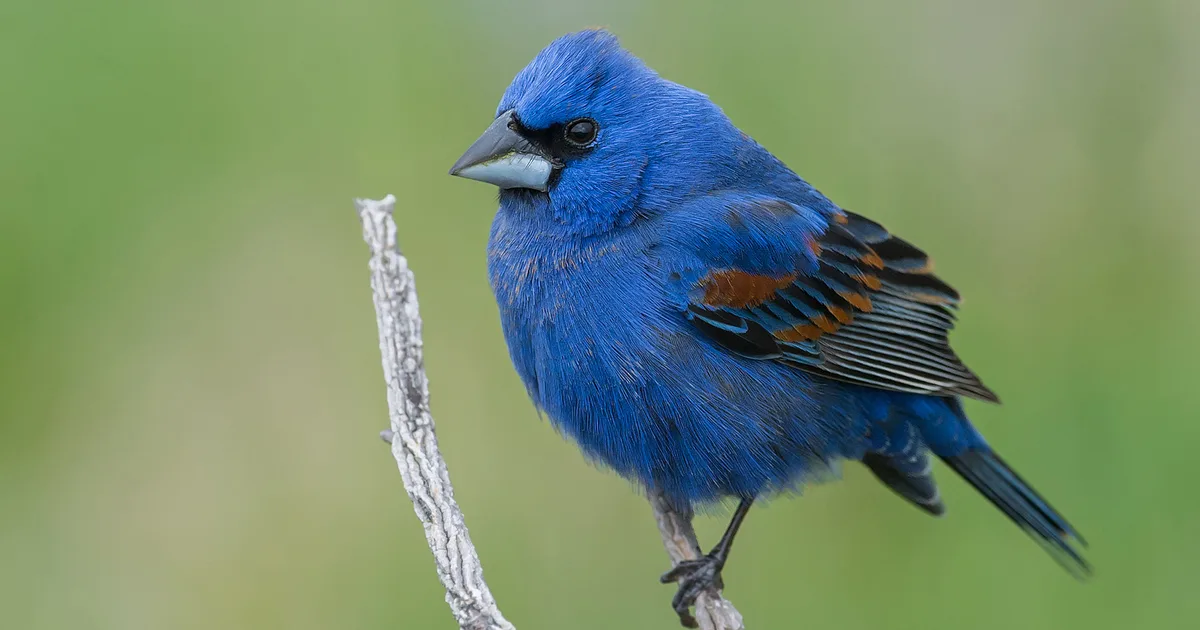In spring and summer, when warblers migrate to Maine, yellow birds, including common ones, can be easily spotted. However, during winter, the American Goldfinch is the most commonly observed yellow bird in this region.
To help you identify the yellow birds you’ve spotted in Maine, this guide provides pictures, identification information, song recordings, and migration patterns.
The majority of yellow birds in Maine are warblers, orioles, or tanagers, and sometimes the female birds look distinctly different from their male counterparts.
With the comprehensive information in this guide, identifying yellow birds will become much easier. The list of yellow birds is arranged based on the frequency of sightings in Maine during spring and summer (May and June) according to ebird checklists.
Yellow birds present in Maine throughout the year include the American Goldfinch and Evening Grosbeak.
Yellow birds found in Maine during the summer months include the Common Yellowthroat, Yellow-rumped Warbler, Cedar Waxwing, Black-throated Green Warbler, Yellow Warbler, American Redstart, Pine Warbler, Magnolia Warbler, Baltimore Oriole, Nashville Warbler, Palm Warbler, Scarlet Tanager, Canada Warbler, Prairie Warbler, Eastern Meadowlark, Yellow-throated Vireo, and Blue-winged Warbler.
Yellow birds seen in Maine during migration periods include the Wilson’s Warbler, Cape May Warbler, Dickcissel, Orchard Oriole, Orange-crowned Warbler, Western Kingbird, and Yellow-headed Blackbird.
So, continue reading to identify those yellow birds you’ve spotted.
26 Yellow Birds Found in Maine:
1. American Goldfinch
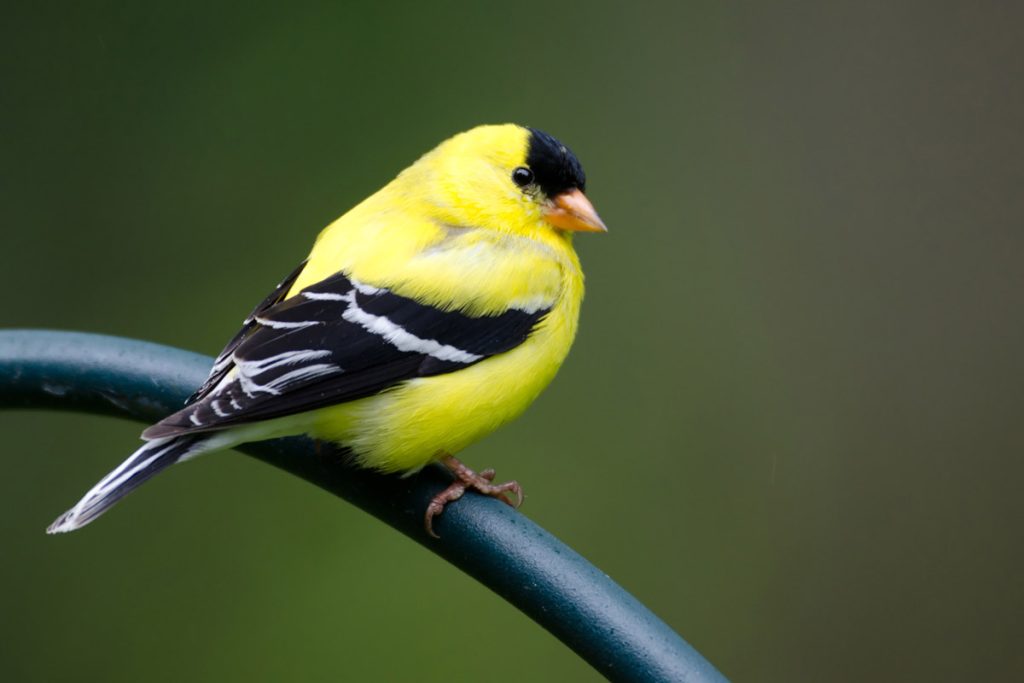
Throughout the year, American Goldfinches can be seen in Maine. However, their numbers increase during the breeding season. They appear in 43% of summer checklists and 27% of winter checklists submitted by birdwatchers in the state.
American Goldfinches are well-known birds, particularly due to the bright yellow and black plumage of the males during spring. In contrast, females have duller brown feathers, similar to the appearance of males during winter.
Spinus tristis
Length: 4.3-5.1 in (11-13 cm)
Weight: 0.4-0.7 oz (11-20 g)
Wingspan: 7.5-8.7 in (19-22 cm)
American Goldfinches can be found across most of North America and are usually resident year-round. However, those breeding in Canada and the Midwest migrate to southern US states during winter.
These birds are often spotted in weedy fields and overgrown areas, where they forage on sunflower, thistle, and aster plants. They are also commonly found in suburban areas, parks, and backyards.
American Goldfinch Song:
American Goldfinches usually build their nests in shrubs. The nests are made from woven rootlets and plant material, firmly attached to branches with spider webs. They lay up to seven eggs, which take around two weeks to hatch. The young birds leave the nest within two to two and a half weeks.
To attract American Goldfinches to your backyard, consider planting thistles and milkweed. They visit most bird feeders and prefer sunflower seeds and nyjer seeds.
Fun Fact: Cowbirds are unsuccessful in getting American Goldfinches to raise their young as their solely vegetarian diet is unsuitable for cowbird chicks, leading to their demise within a few days.
2. Common Yellowthroat
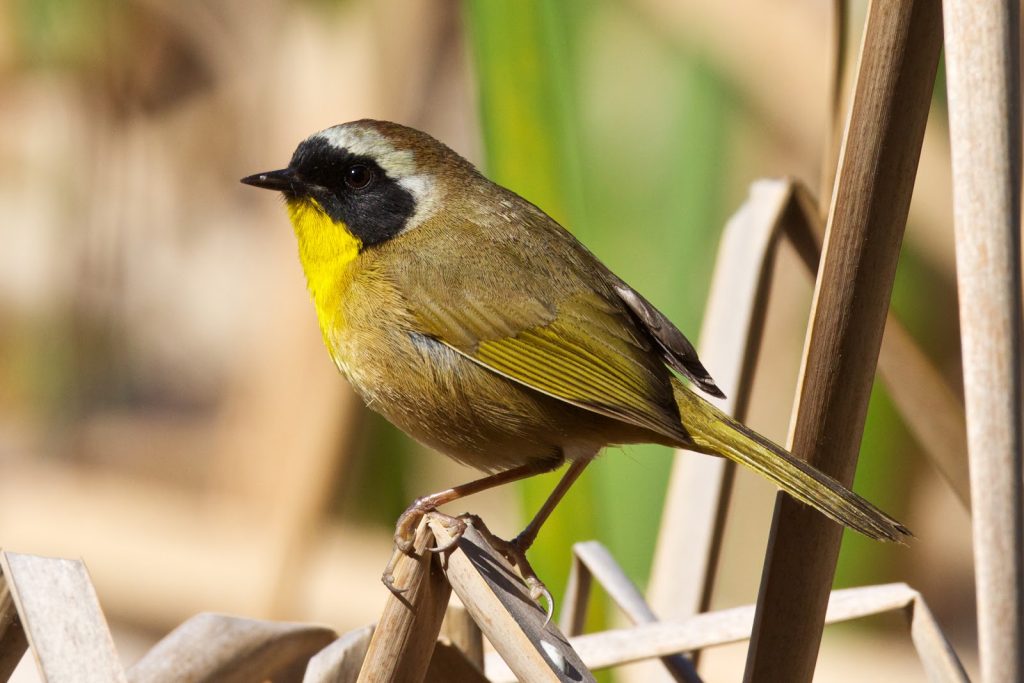
During the breeding season, Common Yellowthroats can be found in Maine from May to October. They are observed in 33% of summer checklists.
Common Yellowthroats are small
songbirds with brownish backs and bright yellow undersides. The males have black masks across their faces. The intensity of yellow coloration can vary geographically, and females may exhibit a more olive appearance underneath.
Geothlypis trichas
Length: 4.3-5.1 in (11-13 cm)
Weight: 0.3-0.3 oz (9-10 g)
Wingspan: 5.9-7.5 in (15-19 cm)
During the summer, Common Yellowthroats breed in most parts of North America, except Alaska and northern Canada. Some individuals remain year-round along the Gulf Coast and in the Pacific Southwest. They migrate south for winter.
Common Yellowthroats are commonly found in marshy or wetland areas and brushy fields with dense vegetation.
Common Yellowthroat Song:
Credit: Paul Marvin, XC629250. Accessible at www.xeno-canto.org/629250.
The nests of Common Yellowthroats are built near the ground in marshy areas, supported by reeds. They are constructed using grass and sedges, forming a platform of leaves and grass. The nests contain up to six eggs, which take around twelve days to hatch. The young birds leave the nest after a similar duration.
To attract Common Yellowthroats to larger backyards, provide dense vegetation and native plants that attract insects.
Fun Fact: The black mask of Common Yellowthroats serves as a signal to courting males, triggering aggressive behavior towards fake birds without masks.
3. Yellow-rumped Warbler
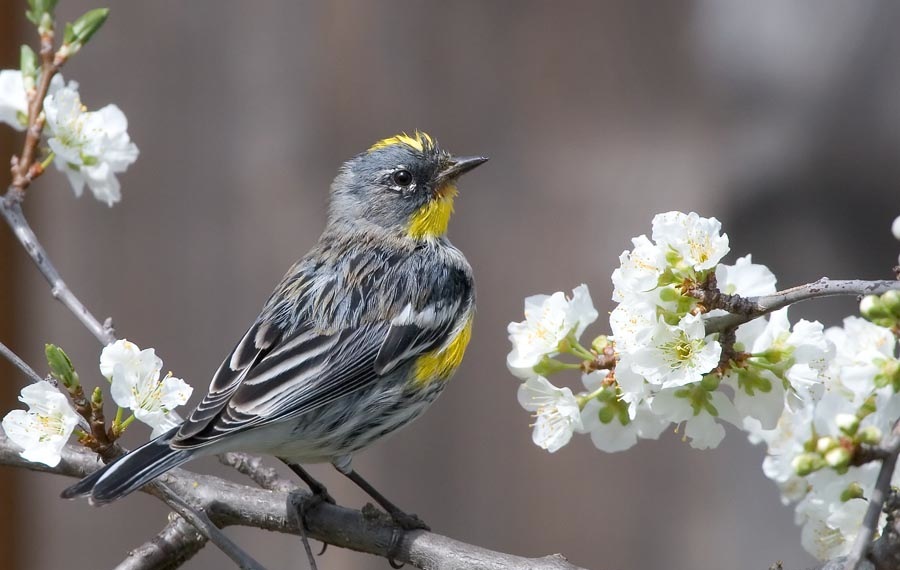
Yellow-rumped Warblers are present in Maine during the breeding season but are primarily observed during migration from April to May and from September to October. They appear in up to 39% of checklists during migration.
Yellow-rumped Warblers have gray plumage with flashes of yellow on their faces, sides, and rump. They exhibit white markings on their wings.
Females may display a slightly brown coloration, while winter birds appear paler brown with bright yellow rumps and sides. In spring, their colors transition back to bright yellow and gray.
Setophaga coronata
Length: 4.7-5.5 in (12-14 cm)
Weight: 0.4-0.5 oz (12-13 g)
Wingspan: 7.5-9.1 in (19-23 cm)
Yellow-rumped Warblers predominantly breed in Canada, parts of the Rockies, and the Appalachian Mountains.
During migration, they can be observed in the Midwest before overwintering in southern and southwestern US states, the Pacific Coast, Mexico, and Central America.
These warblers are commonly found in coniferous forests, especially during the breeding season. In winter, they can be spotted in open areas with fruiting shrubs. Their diet primarily consists of insects during summer and fruit during migration and winter, including bayberries and wax myrtles.
Yellow-rumped Warbler Song:
Credit: Christopher McPherson, XC602699. Accessible at www.xeno-canto.org/602699.
Yellow-rumped Warblers construct nests in conifer trees using twigs, pine needles, and grass, lining them with soft grass, moss, and hair. They lay up to six eggs, which take approximately two weeks to hatch. The young birds leave the nest within two weeks.
To attract Yellow-rumped Warblers to your backyard, provide sunflower seeds, suet, raisins, and peanut butter.
Fun Fact: Yellow-rumped Warblers often form flocks consisting of thousands of individuals during winter, displaying aggression towards other species that come too close.
4. Cedar Waxwing

Cedar Waxwings can be seen in Maine throughout the year, but they are more commonly observed during the breeding season from June to September. They are recorded in 17% of summer checklists and 2% of winter checklists in the state.
Cedar Waxwings are elegant, social birds with pale brown heads, chests, and crests. Their colors fade to gray on the back, wings, and tail. They have a pale yellow belly and bright red wingtips. A narrow black mask extends over their eyes.
Bombycilla cedrorum
Length: 5.5-6.7 in (14-17 cm)
Weight: 1.1 oz (32 g)
Wingspan: 8.7-11.8 in (22-30 cm)
Cedar Waxwings breed in Canada before migrating to the southern US, Mexico, and Central America for winter. They are resident year-round in the northern US states.
Cedar Waxwings are often found in berry bushes, woodlands, grasslands, towns, and areas along streams. They primarily feed on fruit but also consume insects during the summer.
Cedar Waxwing Call:
Credit: Peter Ward and Ken Hall, XC512254. Accessible at www.xeno-canto.org/512254.
Nests of Cedar Waxwings are constructed in trees using twigs, grass, hair, and plant materials. They are lined with pine needles and soft grass. The birds lay up to six eggs, which take around twelve days to hatch. The young birds leave the nest after approximately sixteen days.
To attract Cedar Waxwings to your backyard, plant native trees and shrubs that bear small fruit, such as serviceberry, dogwood, juniper, winterberry, and hawthorn. You can also offer fruit on platform feeders.
Fun Fact: Cedar Waxwings exchange small gifts during courtship rituals, passing them back and forth between potential mates.
5. Black-throated Green Warbler
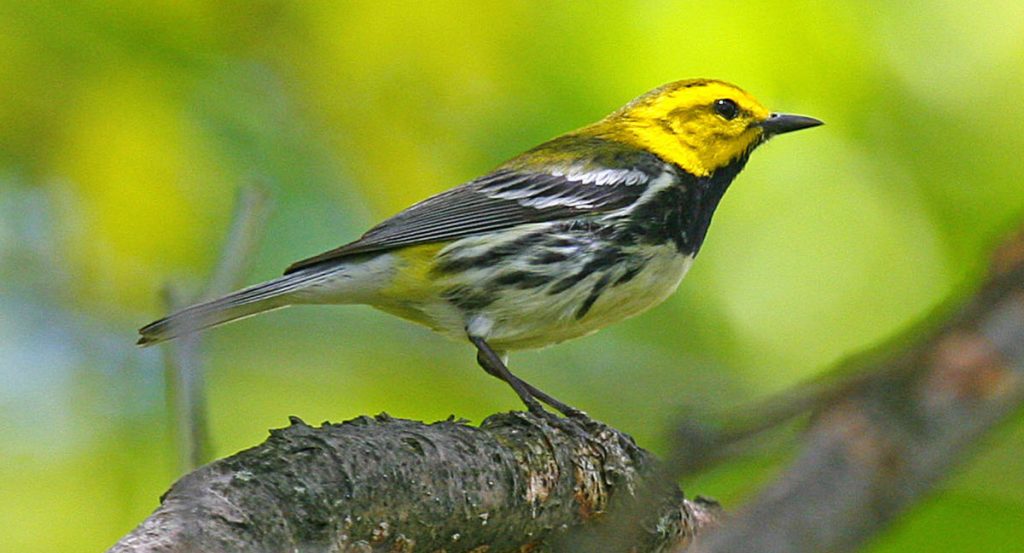
Black-throated Green Warblers can be observed in Maine during the breeding season, from mid-April to November. They appear in 23% of summer checklists in the state.
Black-throated Green Warblers are small yellow songbirds with yellow faces, heads, and olive-yellow backs. They display black streaking on their sides and wings, and their undersides are whitish. Male birds have prominent black patches on their throats, while the size of these patches is smaller in females and juveniles.
Setophaga virens
Length: 4.3-4.7 in (11-12 cm)
Weight: 0.3-0.4 oz (7-11 g)
Wingspan: 6.7-7.9 in (17-20 cm)
Black-throated Green Warblers undertake extensive migrations across the eastern US, traveling to their breeding grounds in the northeastern states and Canada. During migration, they can be observed in the eastern US, while their winter range spans Mexico, northern South America, and the Caribbean.
These warblers are commonly found high up in forests, feeding on insects. Their black throats serve as a distinguishing feature that sets them apart from other small yellow birds.
Black-throated Green Warbler Song:
Credit: Paul Driver, XC187636. Accessible at www.xeno-canto.org/187636.
Nests of Black-throated Green Warblers are located in small trees, close to the trunk. They are constructed using twigs, bark, pine needles, and grass, woven together with spider webs. The nests are lined with animal hair, moss, and feathers. The birds lay around four eggs, which take
twelve days to hatch. The young birds leave the nest after an additional ten days.
To attract Black-throated Green Warblers to your backyard, provide mature trees.
Fun Fact: Male Black-throated Green Warblers can sing over 400 times per hour and perform a unique “gloating” flight after chasing away rivals.
6. Yellow Warbler

Yellow Warblers are observed in Maine during the breeding season, typically from April to October. They appear in 20% of summer checklists. These birds start migrating in October.
Yellow Warblers are small, bright yellow birds with yellow-green backs. Male birds have chestnut streaks on their breasts, while females and juveniles display less intense colors.
Setophaga petechia
Length: 4.7-5.1 in (12-13 cm)
Weight: 0.3-0.4 oz (9-11 g)
Wingspan: 6.3-7.9 in (16-20 cm)
Yellow Warblers undertake long-distance migrations, breeding in Canada and the US (excluding southeastern states), before returning to Central and South America for winter. However, they can be observed during migration in southeastern US states.
These warblers can be found along streams, wetlands, and the edges of fields, often in thickets. They forage primarily on insects, including caterpillars, midges, beetles, bugs, and wasps.
Yellow Warbler Song:
Credit: Richard E. Webster, XC662546. Accessible at www.xeno-canto.org/662546.
Nests of Yellow Warblers are built in small trees or shrubs, using bark, grass, and plant material woven together and secured with spider webs to form a cup. The nests are lined with softer materials like hair, feathers, and plant down. The birds lay up to seven eggs, which take around twelve days to hatch. The young birds leave the nest after an additional ten days.
To attract Yellow Warblers to your backyard, offer suet, oranges, peanut butter, and plants with berries. Plant native species that attract insects without using pesticides or being overly tidy. Additionally, consider providing birdbaths with fountains near secluded plantings for protection.
Fun Fact: Yellow Warblers often face nest parasitism by cowbirds. If detected, Yellow Warblers build a new nest on top of the old one, starting afresh up to six times.
7. American Redstart Female

American Redstarts spend the breeding season in Maine and are primarily observed from May to September. However, a few individuals remain until December. They appear in 15% of summer checklists.
Male American Redstarts display black plumage with bright orange patches and a white belly. Females have olive-gray coloration instead of black and exhibit numerous yellow patches.
Setophaga ruticilla
Length: 4.3-5.1 in (11-13 cm)
Weight: 0.2-0.3 oz (6-9 g)
Wingspan: 6.3-7.5 in (16-19 cm)
American Redstarts breed in eastern US states, Canada, and northwestern US states. They can also be observed during migration in central and western US states.
These birds can be found in deciduous woodlands, parks, and thickets, where they feed on berries such as serviceberry and magnolia. Their diet primarily consists of insects.
American Redstart Song:
Credit: Nick Kiehl, XC522368. Accessible at www.xeno-canto.org/522368.
Nests of American Redstarts are constructed close to the trunk of trees or large shrubs, using bark, grass, and other plant materials. The birds lay up to five eggs, which take just under two weeks to hatch. The young birds leave the nest after a week or two.
To attract American Redstarts to your backyard, provide berry plants like magnolia and serviceberry.
Fun Fact: American Redstart parents selectively feed certain chicks rather than feeding all of them.
8. Pine Warbler
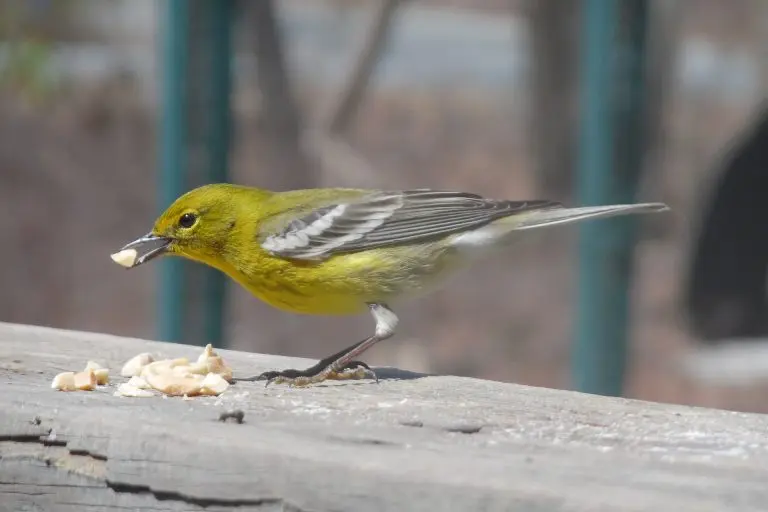
Pine Warblers are recorded in 10% of summer checklists in Maine and are observed from April to December.
Pine Warblers are small, plump yellow birds with olive backs, white lower bellies, and gray wingbars. Females may appear browner and display more white on the belly.
Setophaga pinus
Length: 5.1-5.5 in (13-14 cm)
Weight: 0.3-0.5 oz (9-15 g)
Wingspan: 7.5-9.1 in (19-23 cm)
Pine Warblers breed in northeastern US states before migrating to southeastern US states. Some individuals remain in the southeastern US year-round.
These warblers are often found in pine forests, residing high up in the trees. They feed on caterpillars, beetles, spiders, insects, and larvae. During colder weather, they may also consume fruit and seeds.
Pine Warbler Song:
Credit: Christopher McPherson, XC602052. Accessible at www.xeno-canto.org/602052.
Nests of Pine Warblers are located in pine trees and are constructed using twigs, bark, pine needles, and grass. They are secured with spider silk and lined with feathers and animal hair. The birds lay up to five eggs, which take approximately two weeks to hatch. The young birds leave the nest after an additional ten days.
To attract Pine Warblers to your backyard, provide tube feeders and platform feeders with millet, cracked corn, sunflower seeds, peanut hearts, and suet. Additionally, consider planting native fruit-bearing trees and vines like bayberry, grape, sumac, and Virginia creeper.
Fun Fact: Pine Warblers primarily consume seeds, making them more likely to visit backyard feeders compared to other warbler species.
9. Magnolia Warbler
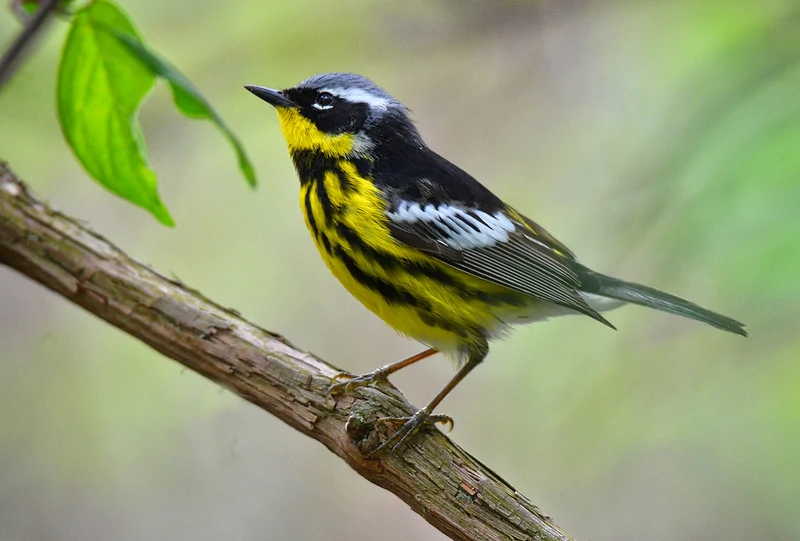
Magnolia Warblers can be observed in Maine from mid-April to mid-November, appearing in 10% of summer checklists.
Male Magnolia Warblers display a black back and yellow undersides. They exhibit black streaking that forms a “necklace” on their necks and extends down over their bellies. Females have a grayer back and lack the distinctive belly streaking.
Setophaga magnolia
Length: 4.3-5.1 in (11-13 cm)
Weight: 0.2-0.5 oz (6-15 g)
Wingspan: 6.3-7.9 in (16-20 cm)
Magnolia Warblers breed across Canada and northeastern US states. They can be observed during migration in the eastern US and spend winter in Central America and the Caribbean.
These warblers are often found on low branches in forests or parks, making them easier to spot during migration. They primarily feed on insects.
Magnolia Warbler Song:
Credit: Peter Ward and Ken Hall, XC512264. Accessible at www.xeno-canto.org/512264.
Nests of Magnolia Warblers are loosely constructed with grass and weeds, positioned close to the trunk of conifer trees. They lay around four eggs, which take approximately twelve days to hatch. The young birds leave the nest after around nine days.
To attract Magnolia Warblers to your backyard, provide native shrubs and trees for them to rest on during migration.
Fun Fact: Magnolia Warblers display the white spots on their tails to attract mates and ward off rivals.
10. Baltimore Oriole Female
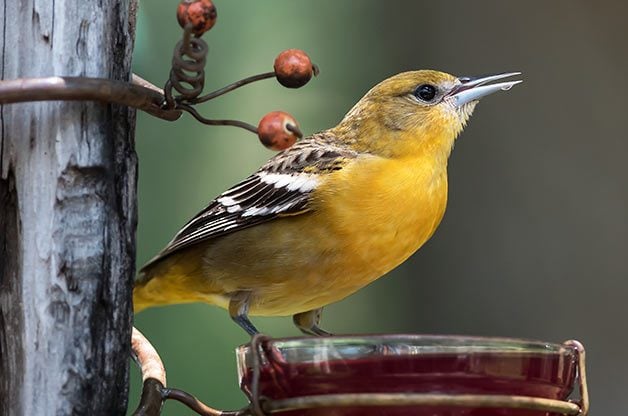
Baltimore Orioles spend the breeding season in Maine, primarily observed in the southern part of the state. They appear in 7% of summer checklists. A few individuals may remain until winter.
Baltimore Orioles are colorful signs of spring in the eastern part of North America. Adult males display bright orange and black plumage with white wing bars.
Females exhibit yellowish coloration on the undersides and head, along with grayish-brown wings. They are approximately the size of a Robin but more slender. Baltimore Orioles belong to the blackbird family.
Icterus galbula
Length: 6.7-7.5 in (17-19 cm)
Weight: 1.1-1.4 oz (30-40 g)
Wingspan: 9.1-11.8 in (23-30 cm)
Baltimore Orioles breed in eastern and central US states, including central-southern Canadian provinces along the US border.
They migrate to Florida, Central America, and the Caribbean for winter, with some individuals leaving as early as July.
Baltimore Orioles can be found in open woodlands, along riverbanks, and in forest edges, foraging on insects and fruit. They often visit parks and backyards as well.
Their diet primarily consists of insects such as beetles, crickets, grasshoppers, spiders, and snails. They also consume various fruits, but they can cause damage to crops like raspberries, mulberries, cherries, bananas, and oranges.
Baltimore Oriole sounds: The flute-like sound of Baltimore Orioles is a delightful aspect of spring. They also produce chattering and sharp alarm calls.
Christopher McPherson, XC690956. Accessible at www.xeno-canto.org/690956.
To attract Baltimore Orioles to your backyard, provide half-cut oranges on a platform feeder or hang them from trees. Oriole feeders with sugar water can also be used. Planting fruiting plants and nectar-rich plants like raspberries, crab apples, and trumpet vines will further attract them.
Fun Fact: Baltimore Orioles construct bag-like nests woven from fibers, exhibiting impressive craftsmanship.
11. Nashville Warbler
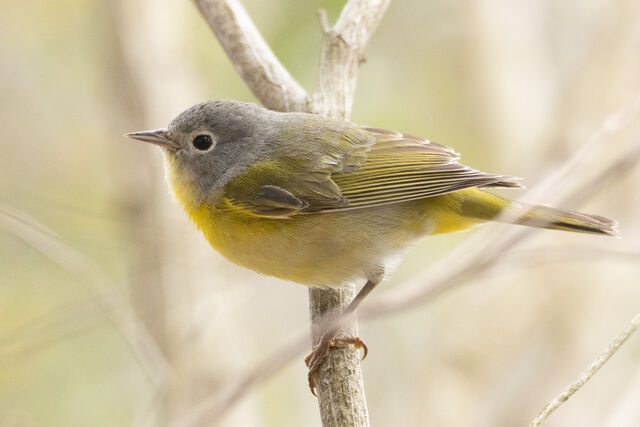
Nashville Warblers can be spotted in Maine during the migration season, typically from late April to early June and late August to early October. They are recorded in 6% of checklists during migration.
Nashville Warblers are small, bright yellow birds with a gray hood and a white eye ring. They have a touch of rusty color on their head and back, and their undersides are pale yellow.
Leiothlypis ruficapilla
Length: 4.3-4.7 in (11-12 cm)
Weight: 0.3-0.4 oz (7-11 g)
Wingspan: 7.5-8.7 in (19-22 cm)
Nashville Warblers breed in the boreal forests of Canada and Alaska. During migration, they can be found in the eastern and central parts of the United States.
These warblers inhabit open woodlands, thickets, and shrubby areas. They feed on insects, including caterpillars, beetles, and spiders.
Nashville Warbler Song:
Credit: Alan Colón, XC451725. Accessible at www.xeno-canto.org/451725.
Nests of Nashville Warblers are built on the ground or in low shrubs, usually hidden under vegetation. The nest is made from twigs, grass, and leaves, lined with finer materials like plant down and hair. They lay up to five eggs, which take around twelve days to hatch. The young birds leave the nest after approximately nine days.
Attract Nashville Warblers to your backyard by providing dense shrubs and plantings for cover during migration.
Fun Fact: Nashville Warblers got their name from being first observed in Nashville, Tennessee, during their migration.
12. Palm Warbler
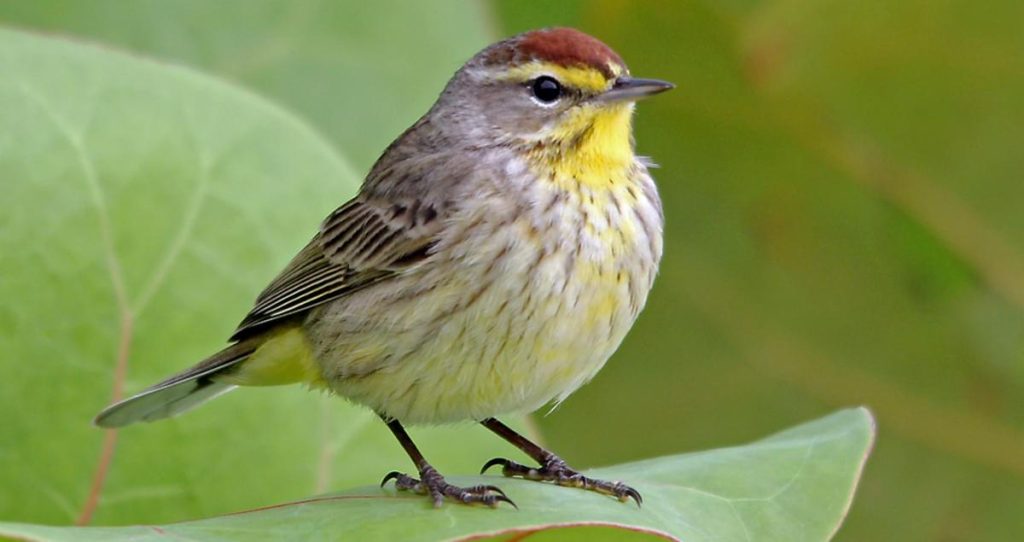
Palm Warblers can be observed in Maine during migration, primarily from late April to early June and late August to early October. They are recorded in 8% of checklists during migration.
Palm Warblers have two distinct plumage variations. The western subspecies has a bright yellow undertail and chestnut cap, while the eastern subspecies has a paler yellow undertail and brownish-gray cap. Both variations have streaked backs.
Setophaga palmarum
Length: 4.7-5.1 in (12-13 cm)
Weight: 0.3-0.4 oz (9-11 g)
Wingspan: 7.5-8.7 in (19-22 cm)
Palm Warblers breed in the northern boreal forests of Canada and Alaska. During migration, they can be found in the eastern and central parts of the United States.
These warblers prefer open areas, including grasslands, fields, and scrubby habitats. They feed on insects, spiders, and small seeds.
Palm Warbler Song:
Credit: Paul Marvin, XC366731. Accessible at www.xeno-canto.org/366731.
Nests of Palm Warblers are constructed on the ground, often in mossy areas. The nest is made from grass, leaves, bark, and twigs, lined with finer materials like hair and feathers. They lay up to five eggs, which take around twelve days to hatch. The young birds leave the nest after approximately nine days.
Attract Palm Warblers to your backyard by providing open areas with low vegetation and patches of moss.
Fun Fact: Palm Warblers are named after their tendency to forage in palm trees during migration, even though they are not exclusive to palm habitats.
13. Scarlet Tanager

Scarlet Tanagers spend the breeding season in Maine and are primarily observed from late May to early September. They appear in 5% of summer checklists.
Male Scarlet Tanagers are striking birds with bright red plumage and black wings and tail. Females and juveniles have olive-yellow coloration, with hints of red on the wings and tail.
Piranga olivacea
Length: 6.3-7.1 in (16-18 cm)
Weight: 0.9-1.3 oz (26-37 g)
Wingspan: 10.2-11.4 in (26-29 cm)
Scarlet Tanagers breed in deciduous and mixed forests across the eastern United States and parts of Canada. During winter, they migrate to Central and South America.
These tanagers can be found high up in the forest canopy, foraging on insects, spiders, and fruits.
Scarlet Tanager Song:
Credit: Devin Bosler, XC560497. Accessible at www.xeno-canto.org/560497.
Nests of Scarlet Tanagers are built on horizontal tree branches, usually positioned high in the canopy. The nest is made from twigs, grass, and leaves, lined with finer materials like rootlets and animal hair. They lay around three to four eggs, which take approximately thirteen days to hatch. The young birds leave the nest after an additional ten days.
Attract Scarlet Tanagers to your backyard by providing tall trees and offering fruits, such as oranges or sliced grapes.
Fun Fact: Male Scarlet Tanagers undergo a molt after breeding, replacing their bright red plumage with a yellow-green color similar to that of females.
14. Canada Warbler

Canada Warblers are observed in Maine during the migration season, typically from late May to early June and late August to early September. They are recorded in 4% of checklists during migration.
Canada Warblers are small, gray-backed birds with bright yellow breasts and a prominent necklace of black streaks across their throats and upper chests.
Cardellina canadensis
Length: 4.3-5.1 in (11-13 cm)
Weight: 0.3-0.4 oz (9-11 g)
Wingspan: 7.1-7.9 in (18-20 cm)
Canada Warblers breed in the boreal forests of Canada and Alaska. During migration, they can be found in the northeastern and central parts of the United States.
These warblers inhabit moist, dense forests, often near streams or wetlands. They feed on insects and spiders.
Canada Warbler Song:
Credit: Alan Colón, XC521096. Accessible at www.xeno-canto.org/521096.
Nests of Canada Warblers are built on or near the ground, usually hidden among vegetation. The nest is made from leaves, grass, and plant fibers, lined with finer materials like rootlets and moss. They lay around four eggs, which take approximately twelve days to hatch. The young birds leave the nest after an additional ten days.
Attract Canada Warblers to your backyard by providing a variety of trees and shrubs near water sources.
Fun Fact: Canada Warblers have one of the longest migrations of any New World warbler, traveling thousands of miles to their breeding and wintering grounds.
15. Prairie Warbler
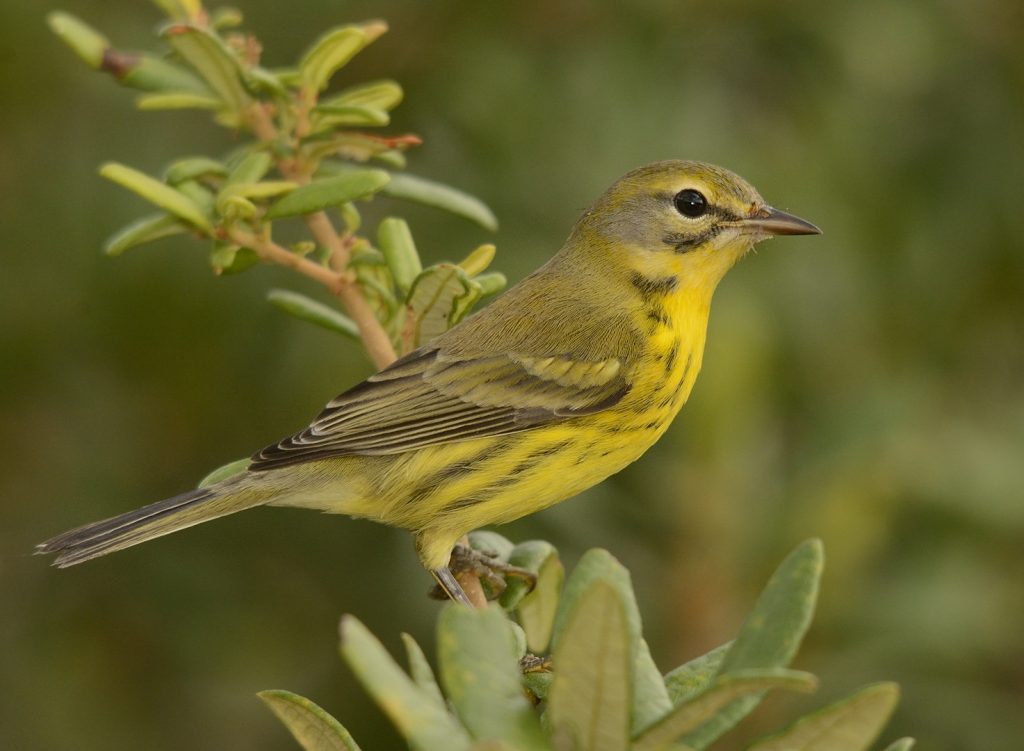
Prairie Warblers can be spotted in Maine during the migration season, typically from late April to early June and late August to early October. They are recorded in 3% of checklists during migration.
Prairie Warblers are small, bright yellow birds with dark streaking on their back and sides. They have a bold black facial pattern with a yellow eyeline.
Setophaga discolor
Length: 4.3-5.1 in (11-13 cm)
Weight: 0.3-0.4 oz (7-11 g)
Wings
pan: 7.5-8.7 in (19-22 cm)
Prairie Warblers breed in shrubby habitats and open woodlands across the eastern United States. During migration, they can be found in the northeastern and central parts of the country.
These warblers prefer low, scrubby vegetation and feed on insects and spiders.
Prairie Warbler Song:
Credit: Andrew Spencer, XC519048. Accessible at www.xeno-canto.org/519048.
Nests of Prairie Warblers are built close to the ground, often hidden within low shrubs or grass. The nest is made from grass, bark strips, and plant fibers, lined with finer materials like rootlets and hair. They lay around three to five eggs, which take approximately twelve days to hatch. The young birds leave the nest after an additional ten days.
Attract Prairie Warblers to your backyard by providing shrubby habitats and maintaining open spaces.
Fun Fact: Despite their name, Prairie Warblers are not exclusive to prairies but can be found in a variety of open habitats, including old fields and powerline corridors.
16. Eastern Meadowlark

Eastern Meadowlarks spend the breeding season in Maine and are primarily observed from late April to early September. They appear in 5% of summer checklists.
Eastern Meadowlarks are medium-sized birds with streaked brown upperparts and bright yellow underparts. They have a distinctive black “V” on their chest and a melodic, flute-like song.
Sturnella magna
Length: 8.3-11 in (21-28 cm)
Weight: 4.9-6.4 oz (140-180 g)
Wingspan: 15.8-16.9 in (40-43 cm)
Eastern Meadowlarks breed in grasslands, meadows, and agricultural fields across eastern and central North America. During winter, they migrate to the southern United States.
These birds forage on the ground, feeding on insects, seeds, and occasionally small vertebrates.
Eastern Meadowlark Song:
Credit: Andrew Spencer, XC245165. Accessible at www.xeno-canto.org/245165.
Nests of Eastern Meadowlarks are built on the ground, usually hidden within a grassy area or field. The nest is made from grasses and stems, forming a cup-shaped structure. They lay around three to six eggs, which take approximately two weeks to hatch. The young birds leave the nest after an additional ten to twelve days.
Attract Eastern Meadowlarks to your backyard by providing open grassy areas and avoiding excessive pesticide use.
Fun Fact: Eastern Meadowlarks have a distinct song that resembles the phrase “spring of the year” and is often associated with open grasslands and meadows.
17. Yellow-throated Vireo

Yellow-throated Vireos are observed in Maine during the migration season, typically from late April to early June and late August to early October. They are recorded in 3% of checklists during migration.
Yellow-throated Vireos are small, olive-green birds with a bright yellow throat and yellow spectacles around their eyes. They have a gray head and back, and their undersides are pale yellow.
Vireo flavifrons
Length: 4.7-5.5 in (12-14 cm)
Weight: 0.3-0.4 oz (9-11 g)
Wingspan: 8.3-9.4 in (21-24 cm)
Yellow-throated Vireos breed in the southeastern United States and parts of southern Canada. During migration, they can be found in the eastern and central parts of the country.
These vireos inhabit deciduous forests and forest edges, foraging for insects among the foliage.
Yellow-throated Vireo Song:
Credit: Curtis Marantz, XC217010. Accessible at www.xeno-canto.org/217010.
Nests of Yellow-throated Vireos are suspended from tree branches, often located high in the canopy. The nest is made from twigs, grass, bark, and plant fibers, lined with finer materials like rootlets and hair. They lay around three to five eggs, which take approximately two weeks to hatch. The young birds leave the nest after an additional twelve days.
Attract Yellow-throated Vireos to your backyard by providing tall trees and a variety of insect-rich habitats.
Fun Fact: Yellow-throated Vireos have a distinctive song that has been described as “three-eight, eight-eight” or “if-I-see-you, if-I-see-you.” They are known for their musical abilities.
18. Blue-winged Warbler
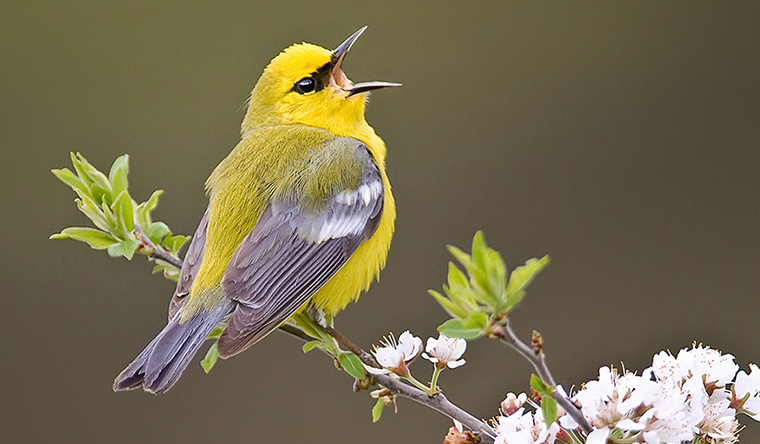
Blue-winged Warblers can be spotted in Maine during the migration season, typically from late April to early June and late August to early October. They are recorded in 2% of checklists during migration.
Blue-winged Warblers are small, golden-yellow birds with a bluish-gray crown and two white wing bars. They have a black eye-line that extends through their cheek.
Vermivora cyanoptera
Length: 4.7-5.1 in (12-13 cm)
Weight: 0.3-0.4 oz (9-11 g)
Wingspan: 7.5-8.3 in (19-21 cm)
Blue-winged Warblers breed in the northeastern United States and parts of southern Canada. During migration, they can be found in the eastern and central parts of the country.
These warblers prefer open habitats, such as shrubby fields and forest edges. They feed on insects, including caterpillars, beetles, and spiders.
Blue-winged Warbler Song:
Credit: Andrew Spencer, XC617719. Accessible at www.xeno-canto.org/617719.
Nests of Blue-winged Warblers are built on the ground, often hidden under low vegetation or shrubs. The nest is made from grasses, leaves, and bark strips, lined with finer materials like rootlets and hair. They lay around three to seven eggs, which take approximately twelve days to hatch. The young birds leave the nest after an additional eight to ten days.
Attract Blue-winged Warblers to your backyard by providing shrubby habitats and open spaces.
Fun Fact: Blue-winged Warblers can hybridize with Golden-winged Warblers, resulting in unique hybrid offspring known as Brewster’s Warbler and Lawrence’s Warbler.
19. Wilson’s Warbler

Wilson’s Warblers are observed in Maine during the migration season, typically from late April to early June and late August to early October. They are recorded in 3% of checklists during migration.
Wilson’s Warblers are small, bright yellow birds with a black cap on the male and a duller olive-green cap on the female. They have a yellow face and throat.
Cardellina pusilla
Length: 4.3-4.7 in (11-12 cm)
Weight: 0.3-0.4 oz (7-11 g)
Wingspan: 7.1-7.9 in (18-20 cm)
Wilson’s Warblers breed in the western United States and parts of Canada. During migration, they can be found in the western and central parts of the country.
These warblers inhabit dense shrubby areas, often near wetlands or streams. They feed on insects, spiders, and small fruits.
Wilson’s Warbler Song:
Credit: Paul Marvin, XC486556. Accessible at www.xeno-canto.org/486556.
Nests of Wilson’s Warblers are built close to the ground, hidden within vegetation or shrubs. The nest is made from grass, leaves, and plant fibers, lined with finer materials like rootlets and hair. They lay around three to six eggs, which take approximately two weeks to hatch. The young birds leave the nest after an additional nine to ten days.
Attract Wilson’s Warblers to your backyard by providing dense shrubby habitats and water sources.
Fun Fact: Wilson’s Warblers are known for their rapid, active foraging behavior, often flicking their wings and tails while searching for insects.
20. Cape May Warbler

Cape May Warblers can be spotted in Maine during the migration season, typically from late April to early June and late August to early October. They are recorded in 2% of checklists during migration.
Cape May Warblers are small, yellow-green birds with a rusty patch on the cheek and a distinctive chestnut crown. They have white wing bars and streaking on their sides.
Setophaga tigrina
Length: 4.7-5.1 in (12-13 cm)
Weight: 0.3-0.4 oz (9-11 g)
Wingspan: 7.5-8.7 in (19-22 cm)
Cape May Warblers breed in the boreal forests of North America, including parts of Canada and Alaska. During migration, they can be found in the eastern and central parts of the United States.
These warblers inhabit coniferous and mixed forests, often foraging at the tips of branches for insects.
Cape May Warbler Song:
Credit: Frank Lambert, XC582445. Accessible at www.xeno-canto.org/582445.
Nests of Cape May Warblers are built in the outer branches of coniferous trees, usually near the top. The nest is made from twigs, grass, and plant fibers, lined with finer materials like rootlets and hair. They lay around four to six eggs, which take approximately two weeks to hatch. The young birds leave the nest after an additional ten to twelve days.
Attract Cape May Warblers to your backyard by providing coniferous trees and maintaining insect-friendly habitats.
Fun Fact: Cape May Warblers have a unique feeding habit of extracting nectar from flowers, using their specialized tubular tongue.
21. Dickcissel
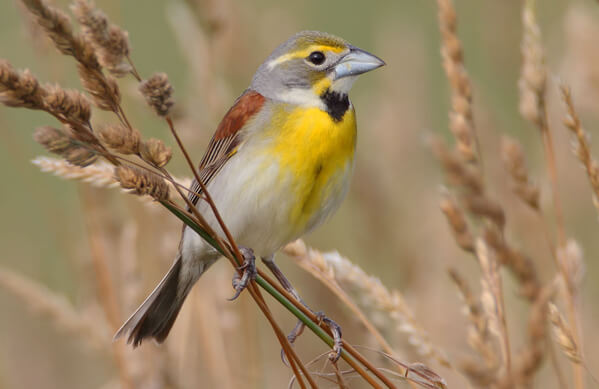
Dickcissels are observed in Maine during the migration season, typically from late May to early September. They are recorded in 1% of checklists during migration.
Dickcissels are medium-sized birds with a yellow breast and a grayish-brown back. Males have a black “V” on their throats and distinctive yellow patches on their wings.
Spiza americana
Length: 5.5-6.3 in (14-16 cm)
Weight: 1.0-1.2 oz (28-34 g)
Wingspan: 9.4-9.8 in (24-25 cm)
Dickcissels breed in grasslands and prairies across the central and southern United States. During migration, they can be found in the central and eastern parts of the country.
These birds prefer open habitats with tall grasses, where they forage on seeds and insects.
Dickcissel Song:
Credit: Paul Marvin, XC400231. Accessible at www.xeno-canto.org/400231.
Nests of Dickcissels are built on the ground, often hidden within dense grasses. The nest is made from grasses and stems, forming a cup-shaped structure. They lay around three to six eggs, which take approximately twelve days to hatch. The young birds leave the nest after an additional ten to twelve days.
Attract Dickcissels to your backyard by providing open grassy areas with tall vegetation.
Fun Fact: The name “Dickcissel” comes from the bird’s distinctive song, which sounds like “dick-dick-ciss-ciss-cissel.”
22. Orchard Oriole
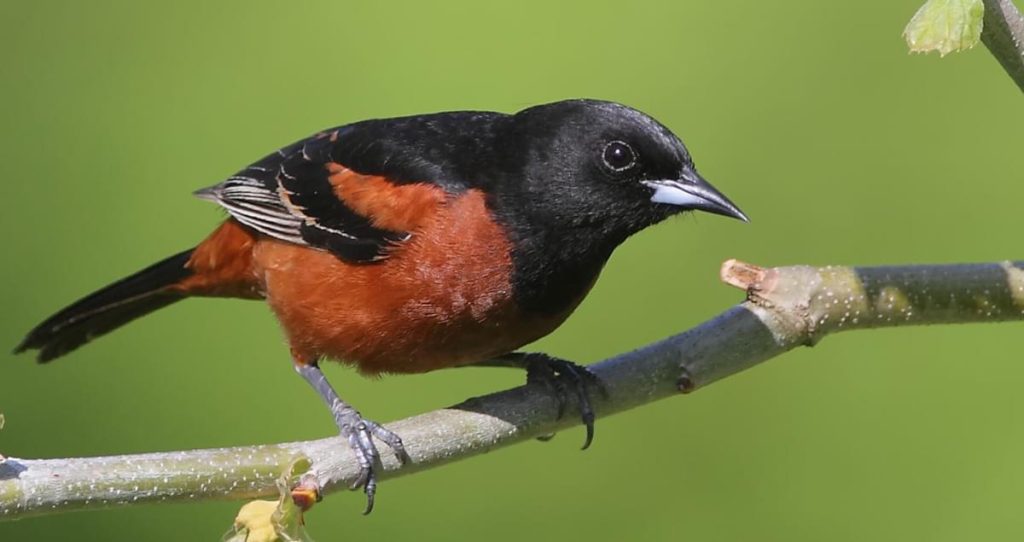
Orchard Orioles spend the breeding season in Maine and are primarily observed from late April to early September. They appear in 2% of summer checklists.
Orchard Orioles are small birds with bright orange plumage in males and olive-green plumage in females. They have a pointed bill and a distinctive black bib on the male’s throat.
Icterus spurius
Length: 6.3-7.1 in (16-18 cm)
Weight: 0.5-0.8 oz (14-23 g)
Wingspan: 9.8-11.8 in (25-30 cm)
Orchard Orioles breed in open woodlands and orchards across the eastern United States and parts of Canada. During winter, they migrate to Central and South America.
These orioles forage for insects, nectar, and fruit, and they can be found in trees and shrubs.
Orchard Oriole Song:
Credit: Andrew Spencer, XC566758. Accessible at www.xeno-canto.org/566758.
Nests of Orchard Orioles are built in trees, typically located on the outer branches. The nest is made from grasses, plant fibers, and bark, forming a hanging structure. They lay around three to six eggs, which take approximately two weeks to hatch. The young birds leave the nest after an additional twelve to fourteen days.
Attract Orchard Orioles to your backyard by providing tall trees and offering fruits and nectar-rich flowers.
Fun Fact: Orchard Orioles are known for their unique nest-building behavior, as they often weave plant fibers into the nest, giving it a bag-like appearance.
23. Orange-crowned Warbler
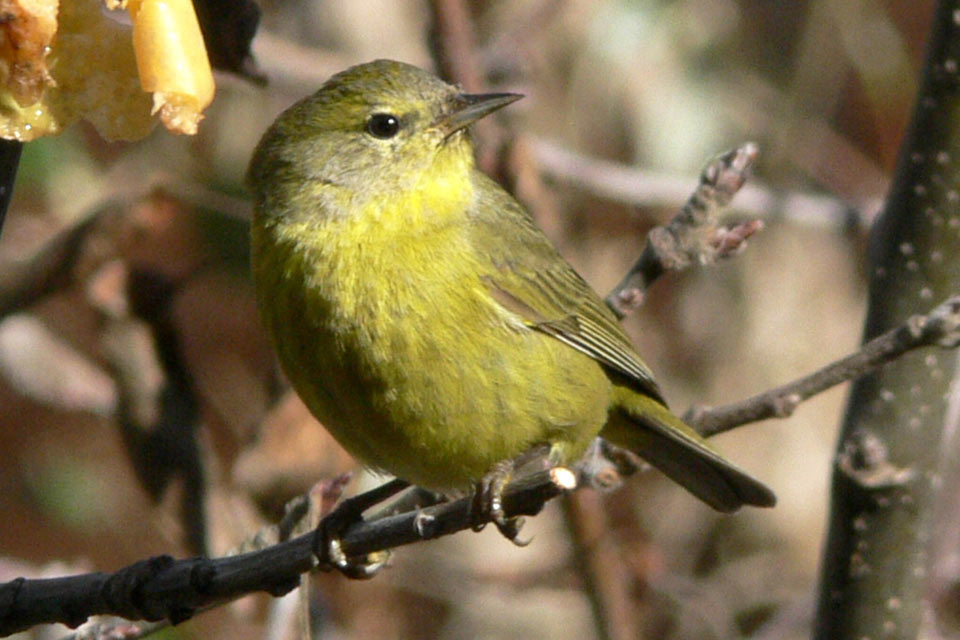
Orange-crowned Warblers can be spotted in Maine during the migration season, typically from late April to early June and late August to early October. They are recorded in 2% of checklists during migration.
Orange-crowned Warblers are small, plain-colored birds with a dull olive-green or grayish-brown plumage. They have an indistinct pale eye-ring and an orange crown patch that is rarely visible.
Leiothlypis celata
Length: 4.7-5.1 in (12-13 cm)
Weight: 0.3-0.4 oz (9-11 g)
Wingspan: 7.1-7.9 in (18-20 cm)
Orange-crowned Warblers breed in the western United States and parts of Canada. During migration, they can be found in the western and central parts of the country.
These warblers inhabit a variety of habitats, including forests, woodlands, and shrubby areas. They forage for insects and spiders among the foliage.
Orange-crowned Warbler Song:
Credit: Andrew Spencer, XC636393. Accessible at www.xeno-canto.org/636393.
Nests of Orange-crowned Warblers are built close to the ground, often hidden within dense vegetation or shrubs. The nest is made from grasses, bark, and plant fibers, lined with finer materials like rootlets and hair. They lay around three to six eggs, which take approximately two weeks to hatch. The young birds leave the nest after an additional ten to twelve days.
Attract Orange-crowned Warblers to your backyard by providing diverse vegetation and maintaining insect-friendly habitats.
Fun Fact: Despite their name, the orange crown patch of Orange-crowned Warblers is often hidden and rarely seen, making it challenging to identify them in the field.
24. Western Kingbird

Western Kingbirds spend the breeding season in Maine and are primarily observed from late April to early September. They appear in 1% of summer checklists.
Western Kingbirds are medium-sized birds with a gray head, a yellow belly, and a dark tail. They have a white throat, a black mask, and a distinctive yellow breast patch.
Tyrannus verticalis
Length: 7.5-8.7 in (19-22 cm)
Weight: 1.0-1.2 oz (28-34 g)
Wingspan: 13.8-15.4 in (35-39 cm)
Western Kingbirds breed in the western United States and parts of Canada. During winter, they migrate to Mexico and Central America.
These kingbirds inhabit open habitats, such as grasslands, meadows, and agricultural areas. They forage for insects by sallying from perches and chasing after their prey.
Western Kingbird Call:
Credit: Andrew Spencer, XC617729. Accessible at www.xeno-canto.org/617729.
Nests of Western Kingbirds are built on horizontal branches, often near the top of trees. The nest is made from twigs, grass, and plant fibers, lined with finer materials like rootlets and hair. They lay around three to six eggs, which take approximately two weeks to hatch. The young birds leave the nest after an additional fourteen to seventeen days.
Attract Western Kingbirds to your backyard by providing perches and open foraging areas.
Fun Fact: Western Kingbirds are known for their aggressive behavior, often defending their nests and territories against larger birds, including hawks and crows.
25. Yellow-headed Blackbird
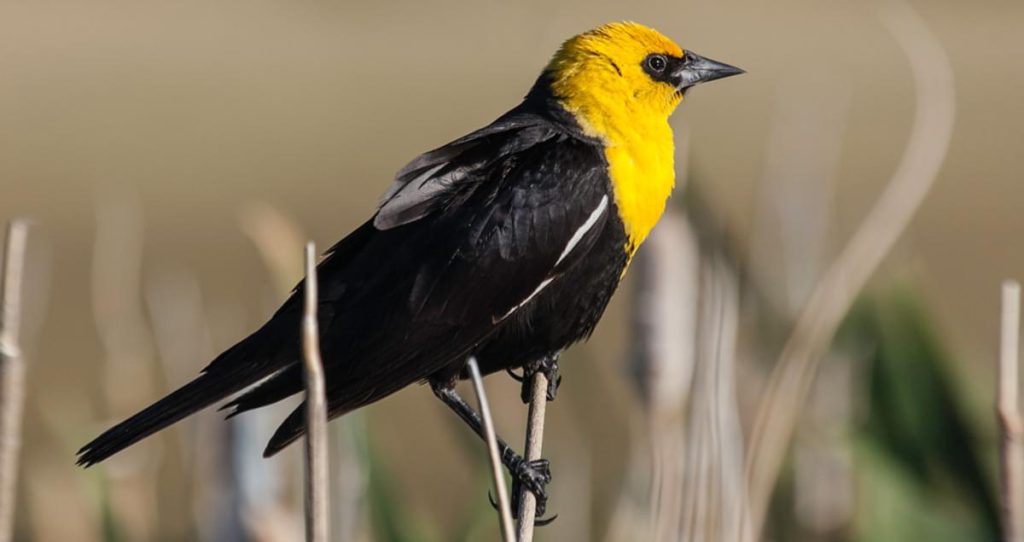
Yellow-headed Blackbirds can be spotted in Maine during the migration season, typically from late April to early June and late August to early October. They are recorded in 1% of checklists during migration.
Yellow-headed Blackbirds are medium-sized birds with a black body, a bright yellow head, and a white wing patch. Males have a distinctive yellow crown that contrasts with their black body.
Xanthocephalus xanthocephalus
Length: 9.1-10.2 in (23-26 cm)
Weight: 2.5-3.2 oz (70-90 g)
Wingspan: 15.4-16.9 in (39-43 cm)
Yellow-headed Blackbirds breed in wetlands and marshes across western and central North America. During migration, they can be found in the central and eastern parts of the United States.
These blackbirds inhabit areas with tall grasses and cattails, often foraging for insects and seeds.
Yellow-headed Blackbird Call:
Credit: Stanislas Wroza, XC577875. Accessible at www.xeno-canto.org/577875.
Nests of Yellow-headed Blackbirds are built in dense marsh vegetation, often suspended over the water. The nest is made from grasses and cattail leaves, forming a woven structure. They lay around three to six eggs, which take approximately two weeks to hatch. The young birds leave the nest after an additional twelve to fourteen days.
Attract Yellow-headed Blackbirds to your backyard by creating wetland-like habitats with tall grasses and offering appropriate food sources.
Fun Fact: Male Yellow-headed Blackbirds have a unique display behavior called “head-throwing,” where they throw their heads backward while singing, displaying their vibrant yellow crown.
26. Indigo Bunting
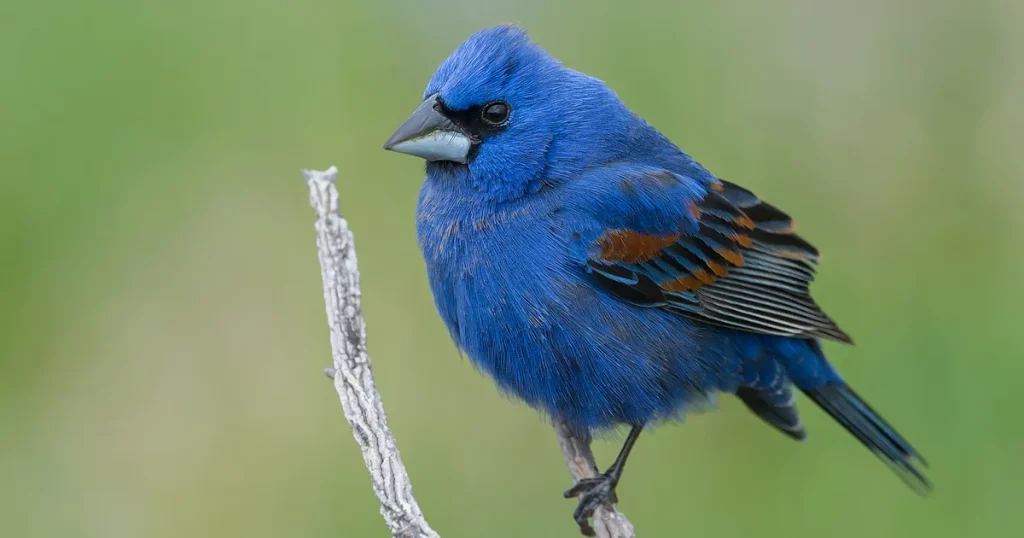
Indigo Buntings spend the breeding season in Maine and are primarily observed from May to September. They appear in 5% of summer checklists.
Indigo Buntings are small, vibrant blue birds with a stout bill. Adult males have deep blue plumage all over, while females and juveniles have a brown plumage with hints of blue.
Passerina cyanea
Length: 4.7-5.5 in (12-14 cm)
Weight: 0.4-0.6 oz (11-17 g)
Wingspan: 7.5-8.7 in (19-22 cm)
Indigo Buntings breed across the eastern and central parts of North America, including parts of Canada. During winter, they migrate to Central and South America.
These buntings prefer open habitats with shrubby vegetation, such as fields, meadows, and woodland edges. They primarily feed on seeds, insects, and berries.
Indigo Bunting Song:
Credit: Paul Marvin, XC637633. Accessible at www.xeno-canto.org/637633.
Nests of Indigo Buntings are built in dense shrubs or small trees, usually a few feet above the ground. The nest is made from grasses, twigs, and plant fibers, lined with finer materials like rootlets and hair. They lay around three to four eggs, which take approximately two weeks to hatch. The young birds leave the nest after an additional nine to ten days.
Attract Indigo Buntings to your backyard by providing shrubby areas and offering a variety of seeds and insects.
Fun Fact: The vibrant blue color of male Indigo Buntings is not derived from pigments but rather from the structure of their feathers, which scatters and reflects light to produce the brilliant blue hue.
That concludes the list of 26 yellow birds in Maine, along with their descriptions, songs, nesting habits, and ways to attract them to your backyard. Happy birdwatching!
